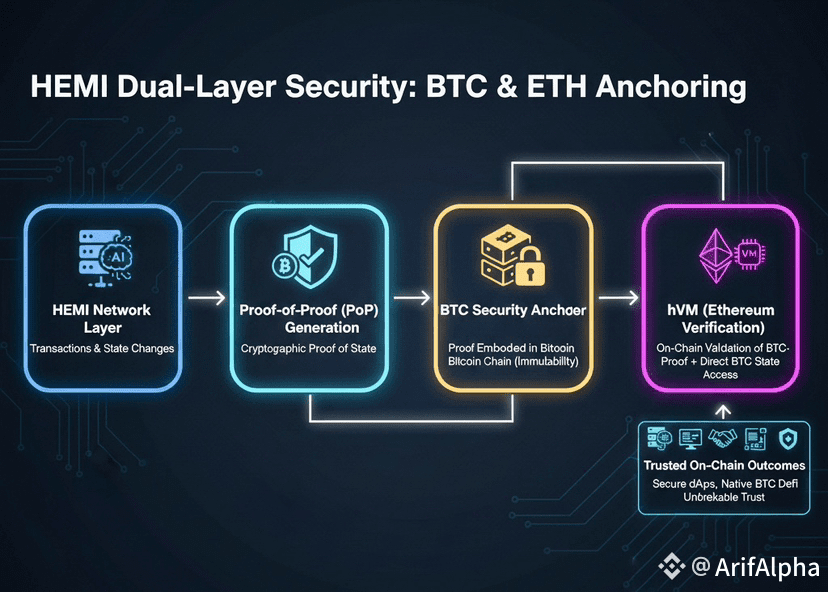For years, the crypto world has been split. You had Bitcoin (BTC), the digital bedrock, offering unmatched security and decentralization. Then there was Ethereum (ETH), the innovation hub, powering almost all the smart contracts and DeFi applications we use. They were two powerful giants, often walled off from each other.
Enter HEMI. This project isn't just another layer-2 bridge; it’s a radical architectural overhaul. HEMI is designed on a "Security First" principle that doesn't simply connect the two networks—it forces its own security state to be validated and anchored by both. It essentially makes its data trust-agnostic, inheriting the best security features from the two most robust blockchains in existence.
The Dual-Layer Security Anchor: BTC's Finality Meets ETH's Flexibility
HEMI's unique security mechanism isn't a single feature; it's a deep, two-part consensus design that acts like a cryptographic lock with dual keys:

1. Bitcoin's Unbreakable Finality via Proof-of-Proof (PoP)
Imagine a notary public stamping the most critical parts of HEMI's history onto the world's most secure ledger: Bitcoin's. That's the core of Proof-of-Proof (PoP).
• The Mechanism: Unlike other solutions that rely on a new, separate set of validators, HEMI's PoP Miners periodically gather the complete state of the HEMI chain. They generate a highly compressed, cryptographic proof of this state—a tiny file that contains verifiable certainty about everything that happened.
• The BTC Anchor: This crucial proof is then recorded as an immutable transaction on the Bitcoin blockchain. This simple act means that Bitcoin's legendary, 15-year-old security and resistance to censorship now backs the historical state of the HEMI network. Even if an attacker somehow compromised HEMI's own internal validators, the definitive, unchangeable truth of its history is permanently recorded on the most resilient blockchain available.
2. Ethereum's Programmable Verification via hVM
While BTC provides the unshakeable security anchor, Ethereum provides the execution and verification environment.
• The hVM Breakthrough: The Hemi Virtual Machine (hVM) is a modified version of the standard Ethereum Virtual Machine (EVM). What makes it unique is that it has a built-in Bitcoin node. This is a game-changer.
• Trustless Interaction: HEMI smart contracts can now natively and directly access real-time Bitcoin data—balances, transaction proofs, UTXOs—without needing slow, vulnerable cross-chain bridges or oracles. This direct, trustless integration allows Ethereum-based applications (like DeFi protocols) to interact with native BTC assets securely and efficiently. They don't have to trust a third party to tell them what's happening on Bitcoin; they can verify it themselves through the hVM.
This combined approach means every critical action on HEMI is secured by Bitcoin's finality and verifiable via Ethereum's smart contract engine. This isn't just interoperability; it's dual-chain security inheritance.
Real-World Trust: Unlocking Bitcoin's $1.2 Trillion Value
This security-first architecture moves Bitcoin from being just "digital gold" to being a fully integrated, programmable asset.
• Native BTC Lending: Imagine a lending protocol on HEMI where you can use native, un-wrapped BTC as collateral. Because the hVM can read the Bitcoin state directly, the smart contract can verify your BTC is locked without relying on a centralized custodian or a risky bridge. This reduces counterparty risk to near zero.
• Advanced Cross-Chain DeFi: Developers can build complex protocols (like options or perpetual futures) that require real-time knowledge of both chain states, all while retaining Bitcoin’s security guarantees. This was practically impossible before HEMI.
HEMI doesn't try to compete with BTC or ETH; it takes on the role of a modular, secure coordination layer that makes them better together. The lock is secured by two keys, and the chain of verification is long and unbreakable.
So, in an era where bridge hacks are common, does HEMI's novel dual-chain security model fundamentally change how you think about cross-chain risk and the future role of Bitcoin in DeFi?
